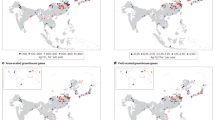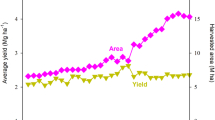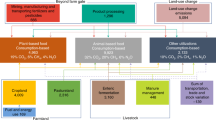Abstract
Africa has been identified as a major driver of the current rise in atmospheric methane, and this has been attributed to emissions from wetlands and livestock. Here we show that rapidly increasing rice cultivation is another important source, and we estimate that it accounts for 7% of the current global rise in methane emissions. Continued rice expansion to feed a rapidly growing population should be considered in climate change mitigation goals.
This is a preview of subscription content, access via your institution
Access options
Access Nature and 54 other Nature Portfolio journals
Get Nature+, our best-value online-access subscription
$29.99 / 30 days
cancel any time
Subscribe to this journal
Receive 12 print issues and online access
$209.00 per year
only $17.42 per issue
Buy this article
- Purchase on Springer Link
- Instant access to full article PDF
Prices may be subject to local taxes which are calculated during checkout


Similar content being viewed by others
Data availability
The Food and Agriculture Organization database (FAOSTAT) is available at https://www.fao.org/faostat/en/#data/QCL. Methane emission estimates from the GCP are available at https://www.icos-cp.eu/GCP-CH4/2019. Source data are provided with this paper.
Code availability
The mathematical algorithm used for the methane emission estimation in our work is publicly available at https://www.ipcc-nggip.iges.or.jp/public/2019rf/pdf/4_Volume4/19R_V4_Ch05_Cropland.pdf.
References
Szopa, S. et al. in Climate Change 2021: The Physical Science Basis (eds Masson-Delmotte, V. et al.) 817–922 (IPCC, Cambridge Univ. Press, 2021).
Global Methane Pledge (Climate and Clean Air Coalition, 2021); https://www.globalmethanepledge.org/
Saunois, M. et al. The global methane budget 2000–2017. Earth Syst. Sci. Data 12, 1561–1623 (2020).
Jackson, R. B. et al. Increasing anthropogenic methane emissions arise equally from agricultural and fossil fuel sources. Environ. Res. Lett. 15, 071002 (2020).
Yin, Y. et al. Accelerating methane growth rate from 2010 to 2017: leading contributions from the tropics and East Asia. Atmos. Chem. Phys. 21, 12631–12647 (2021).
Feng, L., Palmer, P. I., Zhu, S., Parker, R. J. & Liu, Y. Tropical methane emissions explain large fraction of recent changes in global atmospheric methane growth rate. Nat. Commun. 13, 1378 (2022).
Peng, S. et al. Wetland emission and atmospheric sink changes explain methane growth in 2020. Nature 612, 477–482 (2022).
Qu, Z. et al. Attribution of the 2020 surge in atmospheric methane by inverse analysis of GOSAT observations. Environ. Res. Lett. 17, 094003 (2022).
Zhang, Y. et al. Attribution of the accelerating increase in atmospheric methane during 2010–2018 by inverse analysis of GOSAT observations. Atmos. Chem. Phys. 21, 3643–3666 (2021).
Basu, S. et al. Estimating emissions of methane consistent with atmospheric measurements of methane and δ13C of methane. Atmos. Chem. Phys. 22, 15351–15377 (2022).
Oh, Y. et al. Improved global wetland carbon isotopic signatures support post-2006 microbial methane emission increase. Commun. Earth Environ. 3, 159 (2022).
Lu, X. et al. Global methane budget and trend, 2010–2017: complementarity of inverse analyses using in situ (GLOBALVIEWplus CH4 ObsPack) and satellite (GOSAT) observations. Atmos. Chem. Phys. 21, 4637–4657 (2021).
Maasakkers, J. D. et al. Global distribution of methane emissions, emission trends, and OH concentrations and trends inferred from an inversion of GOSAT satellite data for 2010–2015. Atmos. Chem. Phys. 19, 7859–7881 (2019).
Deininger, K. & Byerlee, D. Rising Global Interest in Farmland: Can It Yield Sustainable and Equitable Benefits? (World Bank Publications, 2011).
MacDonald, A. M., Bonsor, H. C., Dochartaigh, B. É. Ó. & Taylor, R. G. Quantitative maps of groundwater resources in Africa. Environ. Res. Lett. 7, 024009 (2012).
Arouna, A., Fatognon, I. A., Saito, K. & Futakuchi, K. Moving toward rice self-sufficiency in sub-Saharan Africa by 2030: lessons learned from 10 years of the Coalition for African Rice Development. World Dev. Perspect. 21, 100291 (2021).
Coalition for African Rice Development, Phase 2 (CARD, 2019); https://riceforafrica.net/wp-content/uploads/2021/09/pamphlet_en1.pdf
Janssens-Maenhout, G. et al. EDGAR v4. 3.2 Global Atlas of the three major greenhouse gas emissions for the period 1970–2012. Earth Syst. Sci. Data 11, 959–1002 (2019).
IPCC 2006 IPCC Guidelines for National Greenhouse Gas Inventories (eds Eggelston, S. et al.) Vol. 2, Ch. 4 (IGES, 2006).
Nikolaisen, M. et al. Methane emissions from rice paddies globally: a quantitative statistical review of controlling variables and modelling of emission factors. J. Clean. Prod. 409, 137245 (2023).
World Rice Statistics: Distribution of Rice Crop Area by Environment (International Rice Research Institute, 2007); https://www.irri.org/resources-and-tools/publications
Saito, K., Asai, H., Zhao, D., Laborte, A. G. & Grenier, C. Progress in varietal improvement for increasing upland rice productivity in the tropics. Plant Prod. Sci. 21, 145–158 (2018).
Saito, K., Laborte, A., Graterol, M. & and Eduardo, J. Global Upland Rice Area 2019 (Harvard Dataverse, 2019); https://doi.org/10.7910/DVN/2DPRHE
Diagne, A., Amovin-Assagba, E., Futakuchi, K. & Wopereis, M. C. in Realizing Africa’s Rice Promise (eds Farrar, N. et al.) 35–45 (CABI, 2015).
TFI 2019 Refinement to the 2006 IPCC Guidelines for National Greenhouse Gas Inventories (IPCC, 2019).
Seck, P. A., Tollens, E., Wopereis, M. C., Diagne, A. & Bamba, I. Rising trends and variability of rice prices: threats and opportunities for sub-Saharan Africa. Food Policy 35, 403–411 (2010).
Tubiello, F. N. et al. The FAOSTAT database of greenhouse gas emissions from agriculture. Environ. Res. Lett. 8, 015009 (2013).
Tubiello, F. N. et al. The contribution of agriculture, forestry and other land use activities to global warming, 1990–2012. Glob. Change Biol. 21, 2655–2660 (2015).
Boateng, K. K., Obeng, G. Y. & Mensah, E. Rice cultivation and greenhouse gas emissions: a review and conceptual framework with reference to Ghana. Agriculture 7, 7 (2017).
Hardy, A., Oakes, G. & Ettritch, G. Tropical wetland (TropWet) mapping tool: the automatic detection of open and vegetated waterbodies in Google Earth Engine for tropical wetlands. Remote Sens. 12, 1182 (2020).
Hardy, A., Palmer, P. I. & Oakes, G. Satellite data reveal how Sudd wetland dynamics are linked with globally-significant methane emissions. Environ. Res. Lett. 18, 074044 (2023).
FAOSTAT Online Statistical Service (Food and Agriculture Organization, 2023); https://www.fao.org/statistics/en/
Acknowledgements
This work was funded by the National Aeronautics and Space Administration Carbon Monitoring System and by the Harvard University Climate Change Solutions Fund. We thank L. Höglund-Isaksson (International Institute for Applied Systems Analysis, Austria) and M. Hayek (New York University, United States) for their advice on African rice.
Author information
Authors and Affiliations
Contributions
Z.C. and D.J.J. contributed to the study conceptualization. Z.C. conducted the data collection and analysis with contributions from D.J.J., N.B., H.L. and H.N. Z.C. and D.J.J. wrote the paper with input from all authors.
Corresponding author
Ethics declarations
Competing interests
The authors declare no competing interests.
Peer review
Peer review information
Nature Climate Change thanks Shushi Peng and the other, anonymous, reviewer(s) for their contribution to the peer review of this work.
Additional information
Publisher’s note Springer Nature remains neutral with regard to jurisdictional claims in published maps and institutional affiliations.
Supplementary information
Supplementary Information
Supplementary Table 1.
Source data
Source Data Fig. 1
Data for both panels of Fig. 1.
Source Data Fig. 2
Data for both panels of Fig. 2.
Rights and permissions
Springer Nature or its licensor (e.g. a society or other partner) holds exclusive rights to this article under a publishing agreement with the author(s) or other rightsholder(s); author self-archiving of the accepted manuscript version of this article is solely governed by the terms of such publishing agreement and applicable law.
About this article
Cite this article
Chen, Z., Balasus, N., Lin, H. et al. African rice cultivation linked to rising methane. Nat. Clim. Chang. 14, 148–151 (2024). https://doi.org/10.1038/s41558-023-01907-x
Received:
Accepted:
Published:
Issue Date:
DOI: https://doi.org/10.1038/s41558-023-01907-x



